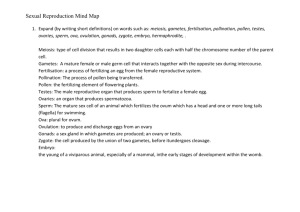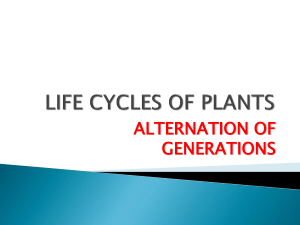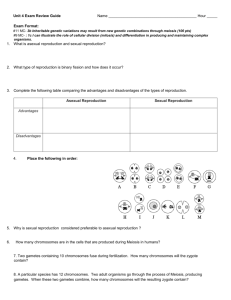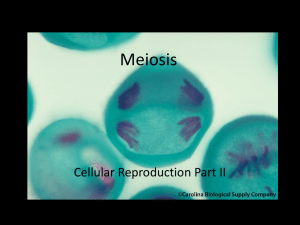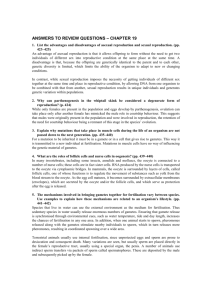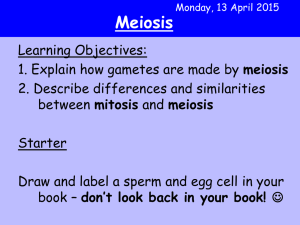Sexual Reproduction
advertisement
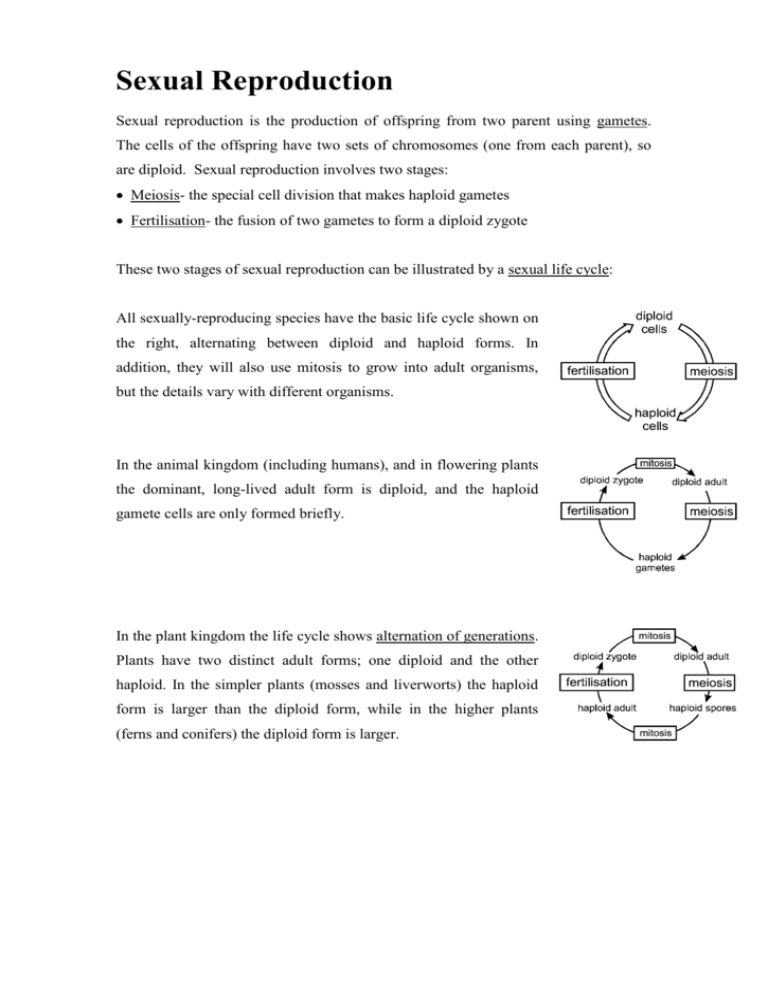
Sexual Reproduction Sexual reproduction is the production of offspring from two parent using gametes. The cells of the offspring have two sets of chromosomes (one from each parent), so are diploid. Sexual reproduction involves two stages: Meiosis- the special cell division that makes haploid gametes Fertilisation- the fusion of two gametes to form a diploid zygote These two stages of sexual reproduction can be illustrated by a sexual life cycle: All sexually-reproducing species have the basic life cycle shown on the right, alternating between diploid and haploid forms. In addition, they will also use mitosis to grow into adult organisms, but the details vary with different organisms. In the animal kingdom (including humans), and in flowering plants the dominant, long-lived adult form is diploid, and the haploid gamete cells are only formed briefly. In the plant kingdom the life cycle shows alternation of generations. Plants have two distinct adult forms; one diploid and the other haploid. In the simpler plants (mosses and liverworts) the haploid form is larger than the diploid form, while in the higher plants (ferns and conifers) the diploid form is larger. Meiosis Meiosis is a form of cell division. It starts with DNA replication, like mitosis, but then proceeds with two divisions one immediately after the other. Meiosis therefore results in four daughter cells rather than the two cells formed by mitosis. It differs from mitosis in two important aspects: The chromosome number is halved from the diploid number (2n) to the haploid number (n). This is necessary so that the chromosome number remains constant from generation to generation. Haploid cells have one copy of each chromosome, while diploid cells have homologous pairs of each chromosome. The chromosomes are re-arranged during meiosis to form new combinations of genes. This genetic recombination is vitally important and is a major source of genetic variation. It means for example that of all the millions of sperm produced by a single human male, the probability is that no two will be identical. Gametes The usual purpose of meiosis is to form gametes- the sex cells that will fuse together to form a new diploid individual. In some algae and fungi the gametes are roughly the same size. This is called isogamy. There are no male and female sexes, but there can be + and - strains, who reproduce together. In all plants and animals the gametes are different sizes. This is called heterogamy. The larger gametes tend to be stationary and contain food reserves (lipids, proteins, carbohydrates) to nourish the embryo after fertilisation. These are the female gametes (ova or eggs in animals, ovules in plants), and they are produced in fairly small numbers. Human females for example release about 500 ova in a lifetime. The smaller gametes can move. If they can propel themselves they are called motile (e.g. animal sperm) If they can easily be carried by the wind or animals they are called mobile (e.g. plant pollen). These are the male gametes, and they are produced in very large numbers. Human males for example release about 108 sperm in one ejaculation. It is this difference in gametes that actually defines the sex of an individual. Those individuals that produce small mobile gametes are the males, and those that produce the larger gametes are the females. In some species (such as most flowering plants) the same individual organisms can produce both male and female gametes, so they do not have distinct sexes and are called hermaphrodites. In other species (such as mammals) there are two distinct sexes, each producing their own gametes. These are called unisexual. Fertilisation Fertilisation is the fusion of two gametes to form a zygote. In humans this takes place near the top of the oviduct. Hundreds of sperm reach the egg and use their tails to swim through the follicle cells (shown in this photo). When they reach the jelly coat surrounding the ovum they bind to receptors and this stimulates the rupture of the acrosome membrane in the sperms, releasing digestive enzymes, which make a path through the jelly coat. When a sperm reaches the ovum cell the two membranes fuse and the sperm nucleus enters the cytoplasm of the ovum. This triggers a series of reactions in the ovum that cause the jelly coat to thicken and harden, preventing any other sperm from entering the ovum. The sperm and egg nuclei then fuse, forming a diploid zygote. In plants fertilisation takes place in the ovary at the base of the carpel. The haploid male nuclei travel down the pollen tube from the pollen grain on the stigma to the ovules in the ovary. In the ovule two fusions between male and female nuclei take place: one forms the zygote (which will become the embryo) while the other forms the endosperm (which will become the food store in the seed). This double fertilisation is unique to flowering plants. The Advantages of Sex For most of the history of life on Earth, organisms have reproduced only by asexual reproduction. Each individual was a genetic copy (or clone) of its “parent”, and the only variation was due to random genetic mutation. The development of sexual reproduction in the eukaryotes around one billion years ago led to much greater variation and diversity of life. Sexual reproduction is slower and more complex than asexual, but it has the great advantage of introducing genetic variation (due to genetic recombination in meiosis and random fertilisation). This variation allows species to adapt to their environment and so to evolve. This variation is clearly such an advantage that practically all species can reproduce sexually. Some organisms can do both, using sexual reproduction for genetic variety and asexual reproduction to survive harsh times.
